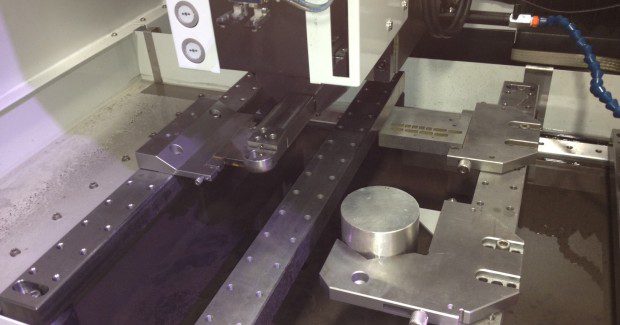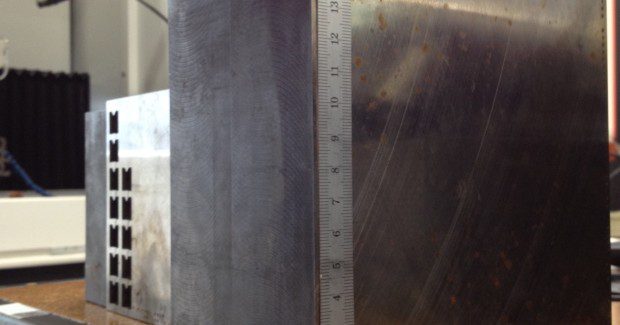A Hole New Game: Precision EDM Holemaking Goes Smaller, Deeper and Faster
While hole-popper systems are quite capable of generating very small accurate holes with good surface quality, advanced EDM drilling systems dramatically increase a shop’s capability to consistently produce tiny holes that are even more accurate and with higher quality.
Posted: September 24, 2013
Demand for smaller, deeper and more precise holes produced as fast and as consistently as possible is driving the advancement of electrical discharge machine (EDM) holemaking technology. What essentially started with conventional EDM hole-popper machines has evolved into advanced EDM drilling systems that further enhance the capabilities of their predecessors in terms of hole size, depth, surface finish and accuracy, as well as in process speed, reliability and simplicity.
In the past, it was a truly significant accomplishment to drill a 0.006 in (0.150 mm) diameter hole 0.125 in deep in hardened steel using a 0.004 in (0.101 mm) diameter electrode on an EDM hole-popper machine. Today’s technology makes it possible to drill the same hole upwards of twice as deep or drill one that is 0.040 in (1 mm) diameter 6 in (152.4 mm) deep and varying in size and straightness no more than 0.001 in (0.025 mm) from its entrance to exit. Plus, being able to do it using only one electrode and little, if any, operator intervention.
Current EDM drilling systems are fundamentally a merging of EDM hole popper technology with that of die-sinker EDMs. At the heart of these super advanced offspring is the latest digital generator technology adapted from the die-sinker side of the family. As opposed to analog systems, these state-of-the-art generators are much more efficient with higher output that delivers speed, consistency and precision. And they consume less energy.
Digital generator technology, such as that of the Intelligent Power Generation (IPG) generator developed by our company, gives EDM drilling machines more precise spark control. That entails different parameter settings for the various stages of the drilling process and according to where the electrode is in the hole. It is this functionality that also helps reduce electrode wear, which, in turn, allows for deeper drilling, increased speed and accuracy and higher surface finish quality.
As part of the spark control, digital generators, via a software approach, modify or adjust spark behavior as the electrode enters a hole and when it exits – a function often referred to as entrance and breakthrough protection.
These protection functions, such as our Intelligent Breakthrough Detection (IBD), prevent instability during hole exiting, shorten actual electrode exiting time, eliminate back-wall striking and help maintain hole diameter size at the point of exit. The function also calculates the necessary electrode retract length so that it can be safely moved to the next hole, as well as how much of the electrode is left and if that remaining amount is enough to do the next hole or if an automatic electrode change should be initiated.
These capabilities are what allow modern EDM drilling systems to accurately, efficiently and automatically process those workpieces involving multi-hole and/or multi-electrode size operations. In the case of a conventional hole popper, the operator – a highly skilled one – would have to perform all of these functions.
For increased EDM drilling productivity, the goal is to generate as many holes as possible or drill as deep as required using the least amount of electrodes. Thus, the more a generator can help reduce electrode wear the better. Plus, less wear on electrodes allows them to cut faster and more accurately by eliminating ‘bullet nosing’ of their tips.
To illustrate, a conventional popper system using a 0.040 in (1 mm) diameter electrode to drill through about 3.937 in (100 mm) of hardened steel, would typically experience 100 to 150 percent of electrode wear. However, in lab testing, we accomplished the same task on our new DRILL 300B, a 3-axis high-speed EDM drilling system with IPG Generator technology, and experienced an electrode-tip wear rate of only 45 percent.
Also during testing, the company used a 0.040 in (1 mm) diameter electrode and burned a hole 1.181 in (30 mm) deep in a carbide test part in just 4.5 minutes at a miniscule electrode-tip wear rate of less than 50 percent. Without digital generator technology, the same hole would have taken over 15 minutes to complete with upwards of 500 percent electrode wear rate.
Such excessive wear, in some cases, can dictate the use of multiple electrodes as well as reduce overall accuracy of the hole. These test hole sizes and depths that have been achieved could never be produced using mechanical methods.
When it comes to hole accuracy, the more an electrode wears, the greater the advent of uneven wear and the higher the tendency for the electrode to ‘walk’ off center, resulting in crooked and angled holes as opposed to straight ones. Because they help reduce wear, digital generators thus prevent such a scenario and contribute to producing straight holes and ones that can be held closer to size from top to bottom. For instance, a 5.905 in (150 mm) deep hole was drilled with a 0.040 in (1 mm) electrode varied in size from top to bottom no more the 0.001 in (0.025 mm).
Besides increasing electrode life, digital generator technology also provides control over heat-affected zones, resulting in surface finishes comparable to those typically attained using a wire-type EDM. Such surface finishes are possible on conventional hole-popper machines, but achieving them would require an extremely skilled operator and a considerable amount of time. With the latest systems, on the other hand, the process is consistent, much quicker and accomplished automatically.
Because they incorporate more of the design qualities of their sinker-EDM parent machine technology, today’s advanced EDM drilling systems are built for continuous unattended, lights-out operations. And because they provide very accurate positioning along with high-quality surface finishes, an increasing amount of shops use the machines for generating finished holes – those that are actually part features, as opposed to EDM start holes – that will not require any secondary finishing operations.
Additionally, with higher positioning accuracy capabilities, EDM drill machine use has further expanded into multiple-hole part applications, especially when the holes are different diameters and must be precisely located on the parts. Such applications, and those done lights-out, involve changing electrodes as well as positioning the machine at a variety of coordinate locations within the worktable.
Today’s technically advanced EDM drill systems essentially put holemaking accuracy in the technological hands of the machine tool. And while existing hole-popper systems are quite capable of generating very small accurate holes with good surface quality, advanced EDM drilling systems dramatically increase a shop’s capability to consistently produce tiny holes that are even more accurate and with higher quality surface finishes.


















